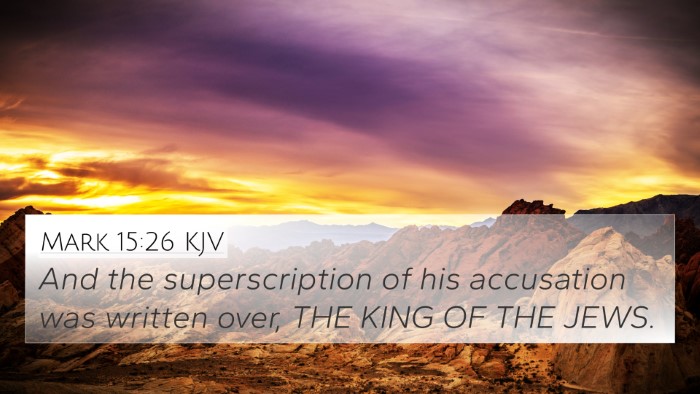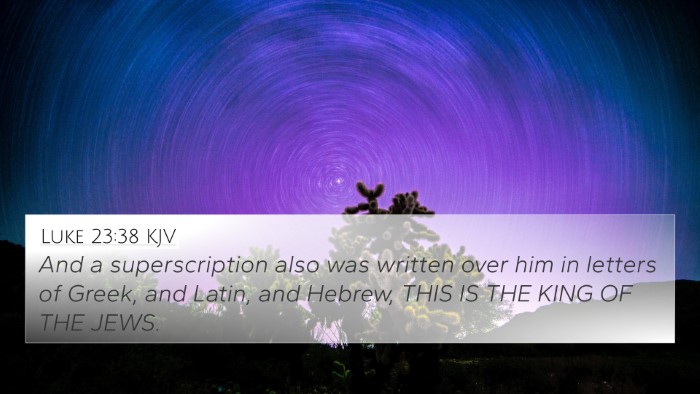Understanding Matthew 27:37
Matthew 27:37 states: "And they set up over his head his accusation written, THIS IS JESUS THE KING OF THE JEWS." This verse is significant as it denotes both the fulfillment of prophetic scripture and the mockery of Jesus' claim to kingship.
Contextual Analysis
This event occurs during the crucifixion of Jesus, where he faces the ultimate humiliation not only in dying a criminal's death but being mocked by the very title that declared his identity. The inscription placed above Him serves as both a declaration and a ridicule.
Commentary Insights
- Matthew Henry: Henry suggests that this inscription was intended as a means of derision, a public taunt meant to undermine Jesus' claim. However, unbeknownst to the accusers, it bore truth, fulfilling the prophetic declaration concerning the Messiah's identity and mission.
- Albert Barnes: Barnes highlights the irony inherent in the inscription. While the Jewish leaders sought to dismiss Jesus as a false king, the sign they erected actually revealed His true role as the King of the Jews, aligning with the prophecies concerning the coming Messiah.
- Adam Clarke: Clarke expands on the significance of the words "King of the Jews," emphasizing that they highlight the culmination of Jesus' entire ministry — a king not crowned in glory yet fulfilling divine authority and purpose through His sacrifice.
Biblical Cross-References
Matthew 27:37 is interconnected with various verses throughout the Bible, creating a rich tapestry of meanings and insights. These connections can help in understanding how different scriptures relate to and illuminate the significance of each other.
- John 19:19-22: The account of Pilate writing the title and the debate over its wording relates closely to this event.
- Isaiah 53:3: This verse foreshadows the rejection of Jesus by His own, which is instrumental in comprehending His kingship and suffering.
- Psalms 22:7-8: The prophetic nature of this psalm resonates with the mockery surrounding Jesus’ crucifixion.
- Zechariah 9:9: This Old Testament prophecy about the coming king riding on a donkey ties into Jesus' royal identity.
- Matthew 21:5: Refers to the fulfillment of prophecy regarding the entrance of the Messiah into Jerusalem, establishing His role as King, albeit misunderstood.
- Luke 23:38: Similar language is used to illustrate the charge placed against Jesus, confirming the mocking nature of the inscription.
- Matthew 2:2: The Magi inquire about Jesus’ birth, emphasizing His rightful claim to kingship even at the beginning of His life.
- Acts 2:36: Peter’s proclamation of Jesus as Lord and Christ connects his messianic identity to the title displayed at His crucifixion.
- Revelation 19:16: Jesus is depicted as the King of Kings, extending His royal identity beyond the mockery endured at His crucifixion.
- Philippians 2:9-11: Discusses the exaltation of Jesus, reaffirming His position as King and Lord despite the initial rejection faced during the Passion.
Thematic Connections
This verse can serve as a focal point for various themes explored in the Bible:
- Mockery vs. Truth: The inscription showcases the irony of human rejection alongside divine reality.
- Suffering Servant: It ties into the larger narrative of Christ's suffering as part of God's redemptive plan.
- Royal Identity: This verse starkly presents Jesus’ royal identity juxtaposed against the backdrop of suffering and sacrifice.
- Prophecy Fulfillment: It marks the realization of Old Testament prophecies regarding the Messiah.
Practical Application
Understanding Matthew 27:37 encourages deeper reflection on the nature of Christ’s kingship and our response to it. As believers, it prompts us to consider our view of Jesus, recognizing Him as King despite the world’s perspective.
Conclusion
Matthew 27:37 encapsulates profound truths about the identity of Jesus. Through cross-referencing various scriptures, we uncover the intricate web of connections that shape our understanding of His role as the King of the Jews and the implications of His sacrifice.





